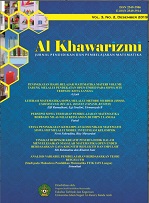TINGKAT BERPIKIR KREATIF PESERTA DIDIK DALAM MENYELESAIKAN MASALAH MATEMATIKA OPEN ENDED BERDASARKAN GAYA KOGNITIF REFLEKTIF DAN IMPULSIF
DOI:
https://doi.org/10.22373/jppm.v3i2.7353Keywords:
creative thinking, open-ended, reflexive cognitive styleAbstract
This study aims to determine the level of creative thinking of students in solving math problems. This type of research is a verification qualitative research. The research subjects were eight people, the first grade students of Ar-Raniry Banda Aceh UIN. Subject selection was made based on the Matching Familiar Figure Test (MFFT), namely four reflective students and four impulsive students. The research data were obtained from the research subjects' written answers, namely the mathematics creative thinking test (TBKM) and the results of the interview. To test the credibility of the data the researcher triangulated. In this study, the triangulation used was the method triangulation by comparing TBKM and interviews. Students' creative thinking skills can be seen based on the achievement of mathematical creative thinking indicators. The results of the study are as follows, the reflective subject's creative thinking level 1 on compound interest calculation material is level 4, which meets four indicators of fluency, novelty, flexibility, and elaboration, the creative thinking level of reflective subject 1 on the straight-line equation related to supply and demand functions is the level 3 namely meeting the three indicators of fluency, flexibility, and elaboration. The reflective subject's creative thinking level 2 on compound interest calculation material is level 3, which is fulfilling three indicators of fluency, flexibility, and elaboration, the reflective subject's creative thinking level 2 on the straight-line equation related to supply and demand functions is level 4, which meets four indicators of fluency, novelty , flexibility and elaboration. The level of reflective subject creative thinking 3 on compound interest calculation material is level 3, which is fulfilling three indicators of fluency, novelty, and elaboration, the level of creative thinking reflective subject 3 on the material of straight-line equations related to supply and demand functions is level 1 namely meeting two indicators of fluency and elaboration. The reflexive subject's creative thinking level 4 on compounded calculation material is level 4, which is fulfilling four indicators of fluency, novelty, flexibility, and elaboration, the reflective subject's creative thinking level 4 on the straight-line equation material related to supply and demand functions is level 4, which is meeting four indicators fluency, novelty, flexibility and elaboration. The level of creative thinking of the subjects Impulsive 1, Impulsive 2, and Impulsive 4 on the compound interest calculation material and on the straight line equation material is level 1 which satisfies two indicators of fluency and elaboration. The level of creative thinking of the impulsive subject 3 on the compound interest calculation material and on the straight line equation material is level 3 which is to fulfill three indicators of fluency, flexibility, and elaboration.References
Azhari, B., & Irfan, A. (2019). Model-Eliciting Activities dalam Menganalisis Kreativitas Pemecahan Masalah Matematika pada Mahasiswa Pendidikan Matematika Di PTKIN Aceh. Al Khawarizmi: Jurnal Pendidikan dan Pembelajaran Matematika, 2(1), 1-18.
BSNP (2006). Standar Isi dan Standar Isi Untuk Satuan Pendidikan Dasar dan Menengah. Jakarta: Kemendiknas
Beetlestone, F. (2012). Creative Learning. Bandung: Nusa Media
Firmansyah, A. (2011). Profil Kreatifitas Penyelesaian Masalah Matematika Siswa SMP Berdasarkan Gaya Konitif Reflektif dan Impulsif. Tesis Magister. Tidak dipublikasikan. Universitas Negeri Surabaya.
Miles, M. B. & Huberman, A. M. (1992). Analisis Data Kualitatif. Jakarta: Universitas Indonesia
Munandar, U. (2004). Pengembangan Kreativitas Anak Berbakat. Jakarta: Rineka Cipta
Nasution, S. (2008). Berbagai Pendekatan dalam Proses Belajar dan Mengajar. Jakarta: PT Bumi Aksara.
Firestone, P., & Douglas, V. I. (1977). The Effects of Verbal and Material Rewards and Punishers on the Performance of Impulsive and Reflective Children. Child Study Journal, 7 (2), 71–78
Rahman, A. (2008). Analisis Hasil Belajar Matematika Berdasarkan Perbedaan Gaya Kognitif Secara Psikologis dan Konseptual Tempo pada Siswa Kelas X SMA Negeri 3 Makasar. Jurnal Pendidikan dan Kebudayaan, 14 (2), 452-473.
Rahmawati, D. T. (2010). Kompetensi Berpikir Kritis Dan Kreatif dalam Pemecahan Masalah Matematika di SMP Negeri 2 Malang. Tesis, tidak dipublikasikan. Universitas Negeri Malang.
Reynolds, C. & Janzen, E. (2007). Encyclopedia of Special Education: A Reference for the Education of Children, Adolescents, and Adults with Disabilities and Other Exceptional Individuals. Hoboken, N.J: John Wiley & Sons.
Siswono, T. Y. E. (2008). Model Pembelajaran Matematika Berbasis Pengajuan Pemecahan Masalah Untuk Meningkatkan Kemampuan Berpikir Kreatif. Surabaya: Unesa University Press.
Slavin, R. E. (2008). Psikologi Pendidikan: Teori dan Praktik. (Terjemahan Marianto Samosir). Jakarta: Indeks
Sternberg, R. J. (2008). Psikologi Kognitif. Ed.4. Yogyakarta: Pustaka Pelajar.
Warli (2010). Profil Kreativitas Siswa yang Bergaya Kognitif Reflektif dan Siswa yang Bergaya Kognitif Impulsif dalam Memecahkan Masalah Matematika. Disertasi, tidak dipublikasikan. Universitas Negeri Surabaya.

